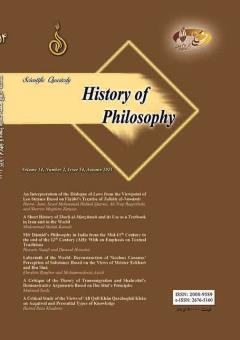-
-
List of Articles
-
Open Access Article
1 - يادداشت سردبير
Hossein Kalbasi Ashtari -
Open Access Article
2 - An Interpretation of the Dialogue of Laws from the Viewpoint of Leo Strauss Based on Fārābī’s Treatise of Talkhīṣ al-Nawāmīs
Havva Jami Seyed Mohammad Hakkak Qazvini Ali Naghi Baghershahi Shervin Moghimi Zanjani -
Open Access Article
3 - A Short History of Sharḥ al-Manẓūmah and its Use as a Textbook in Iran and in the World
Mohammad Mahdi Kamali -
Open Access Article
4 - Mīr Dāmād’s Philosophy in India from the Mid-11th Century to the end of the 12th Century (AH): With an Emphasis on Textual Traditions
Hossein Najafi Davood Hosseini -
Open Access Article
5 - Labyrinth of the World: Deconstruction of Nicolaus Cusanus’ Perception of Substance Based on the Views of Meister Eckhart and Ibn Sīnā
Ebrahim Ranjbar Mohammadreza Asadi -
Open Access Article
6 - A Critique of the Theory of Transmigration and Shahrzūrī’s Demonstrative Arguments Based on Ibn Sīnā’s Principles
Mahmud Saidiy -
Open Access Article
7 - A Critical Study of the Views of ‘Alī Qulī Khān Qarchoghāi Khān on Acquired and Presential Types of Knowledge
Hamid Reza Khademi
-
The rights to this website are owned by the Raimag Press Management System.
Copyright © 2017-2026







